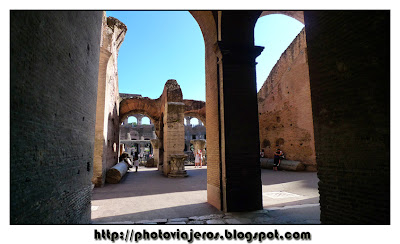El Coliseo Romano
The gladiator lying on the sand with a sword pressing his jugular looks to the Emperor, it all depends on where point the thumb. If is up live and get a reward, but if the finger is pointing down, his life will end at that moment under the eye of the 50,000 spectators who pack the stands of the Roman Coliseum.
hard to imagine the legendary battles represented here 2000 years ago saw the current dilapidated that it exposes the tunnels, dungeons and rooms where slaves, gladiators and wild beasts waiting for their turn to feed the appetite for blood and violence of the old Roman town. That if it had to be a pressure cooker and not the soccer fields Current ...
The monument, declared a World Heritage Site by UNESCO in 1980, is located in the center of the city of Rome from 80 AD, when after more than 8 years of work opened with the conclusion of games that lasted 100 days, which according to some historians as Dion Cassius, it is estimated that more than 9000 animals were killed.
It was the Emperor Vespasian, who ordered its construction in the very heart of the Empire, thus breaking with the standard of building this type of buildings outside the cities.
This huge amphitheater was really impressive dimensions, 189 meters long by 156 wide and over 50 meters high, which is divided into bleachers where each class had its place:
At the podium, located on the lower the building and close to the sand, stood the emperor, senators and other distinguished Romans. The following story
maeniarium were called, and they could find, starting with the lower bowl and ending at the top, the rest of the aristocracy in the first place, people rich, the poor and the last level in the highest area for poor women.
The way to access each of the levels is made through interior corridors and vomitoria, the same structure that is currently used in soccer stadiums, and probably was copied from this building.
On the facade, we can distinguish three levels with arches in which formerly were placed statues of gods and emperors, and a final level without arms which can see the holes where they were placed wooden masts that supported the ropes and pulleys to cover cloth called velarium, which had just anchored guy lines on the outside of the arena and allowed to fold and unfold this cover to protect spectators from the sun and sand the entire area where the games were held.
The coliseum was the best representation of the Latin phrase panem et circus (bread and circuses), which sums up everything that rulers needed to keep the populace entertained and well able to handle the people at will .
The main applications of the Colosseum were the epitome of great battles, hunting of wild animals, among which were lions, giraffes, elephants, rhinos ... and the well-known gladiator fights, whose term comes from the Latin gladius (sword), whence the word gladiator or carrier the sword.
Other uses less known were the simulations of naval battles (navalia proelia), where it flooded the area of \u200b\u200bthe sand to make warships and recreate famous naval battles of the time, or recreations of landscapes with trees, animals and buildings where they represented some mythological work.
is estimated that all games played at the Coliseum since it opened until the middle of V century, died of 500,000 to 1,000,000 people, which gives an idea of \u200b\u200bthe violence and brutality of the shows represented there.
From the Middle Ages, this amphitheater has been home to churches, cemeteries, forts and has even used as a quarry for building palaces and other monuments, in addition to supporting several earthquakes that have been slowly making a dent in its structure throughout its history.
Today is one of tourist symbols of the city of Rome and one of the most visited monuments.
To avoid the huge queues to visit the inside, I recommend you buy the tickets at the Palatine and the Roman Forum, as the ticket is the same for the 3 and is valid for 2 days.
RATES (Summer 2009):
€ 12.00:
normal entry € 7.50: reduced rate - 18-24 year-olds, students, teachers ...
Free: under 18 and 65
I leave the arena's official website that you may find updated information on schedules, opening dates ... Http://www.il-colosseo.it/
After buying tickets, if you want to start your visit at 3 campuses by the Coliseum, you can skip straight to the turnstiles avoiding the long queue of ticket .
From one level of arcs, we can poke at and around contemplate the nearby Palatine Hill and the Arch of Constantine.
between the Colosseum and one of the entrances to the Roman Forum, is the Arch of Constantine, a triumphal arch commemorating the victory of Constantine I in the battle of Milvian Bridge in 312 AD
This arc of 21 meters high and 26 wide, is built of marble and is the old route taken by those emperors who entered the city victorious through the Via Triumphalis.
As you can see in the pictures below, the night visit to the area around the Coliseum is a good option to see this monument without so many tourists and Romans delighted to be disguised as a picture with you to a "reasonable" price.
ojito
Especially when taking a photo of the area with your own camera you see one of them, as you can get a tip for exit request photo! jajaja
















0 comments:
Post a Comment